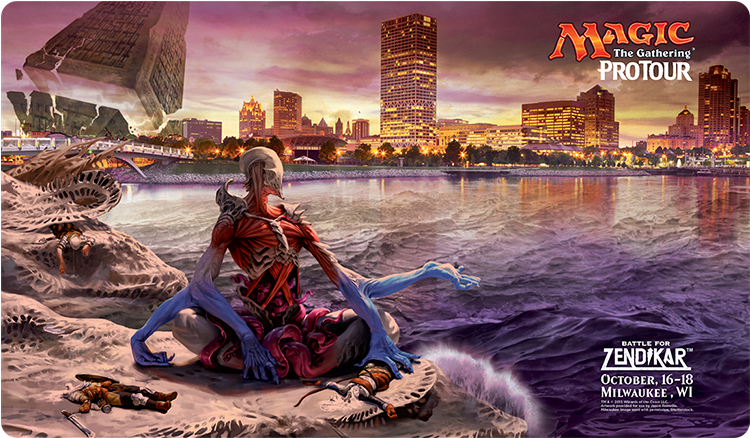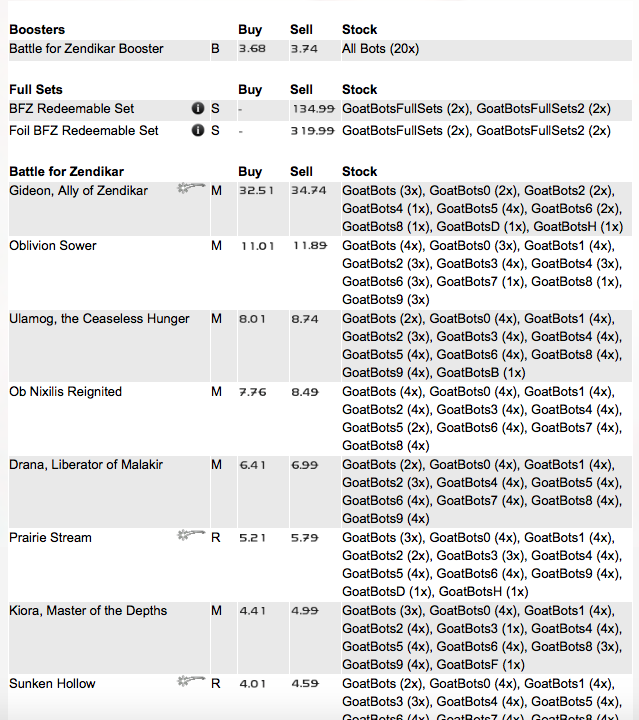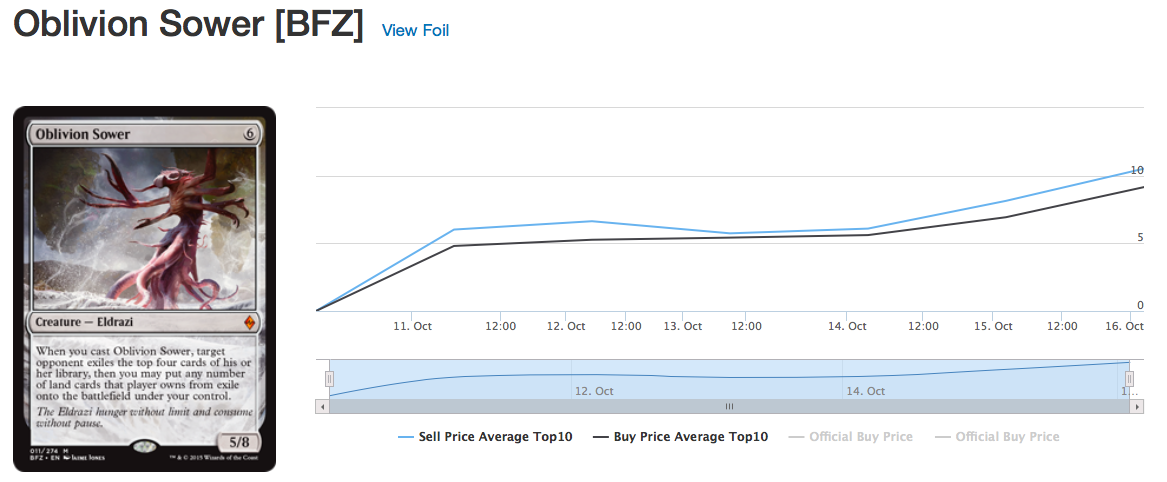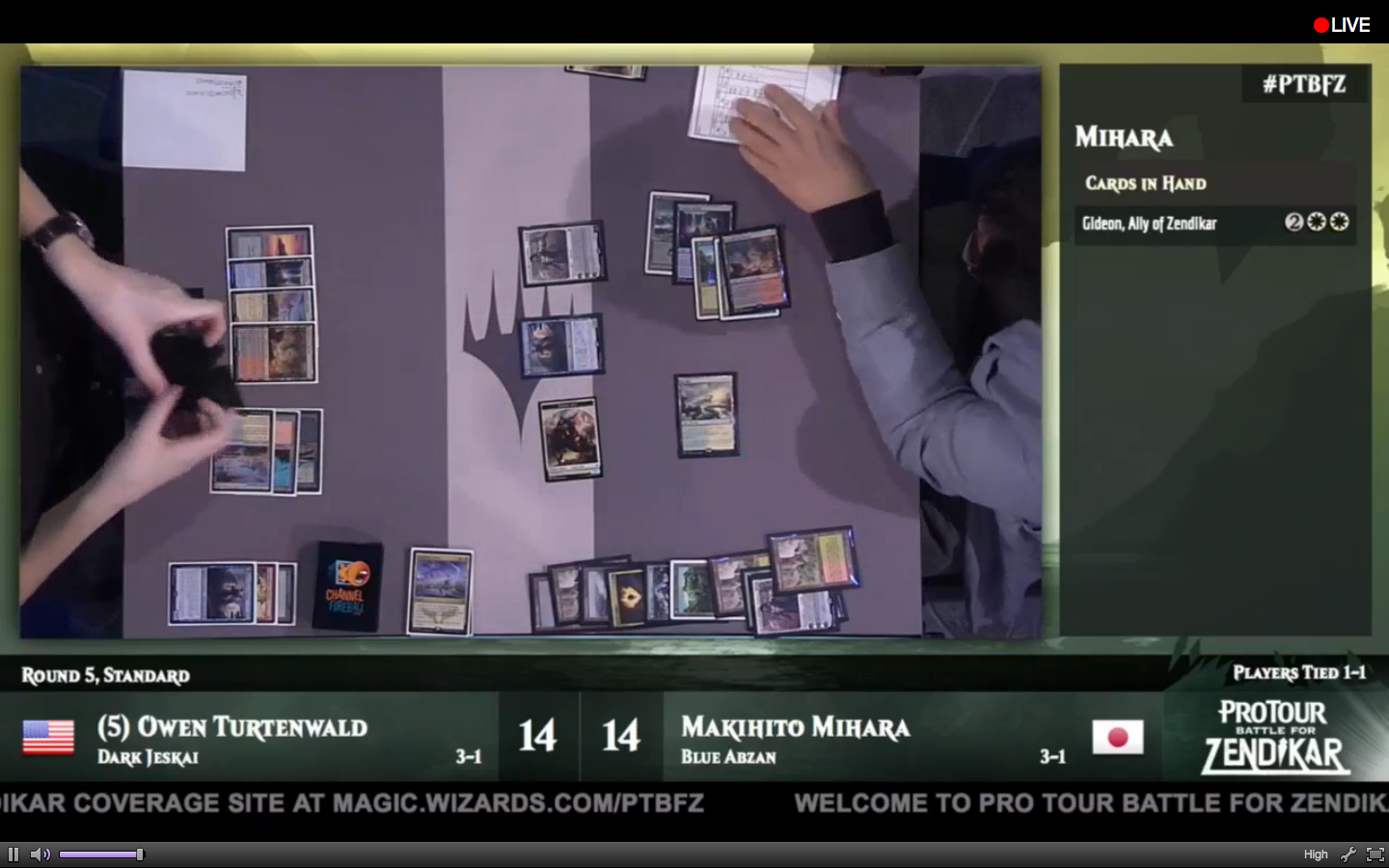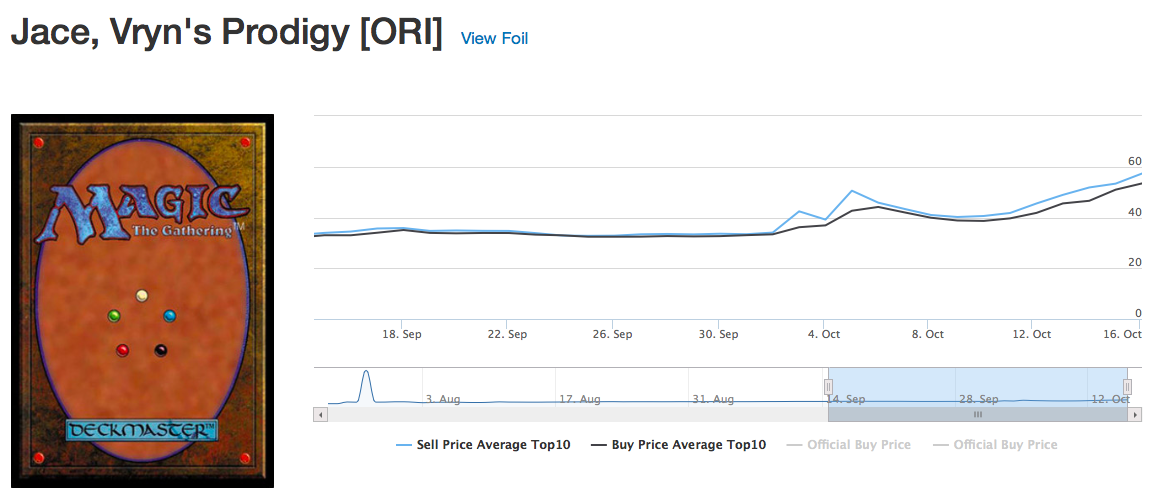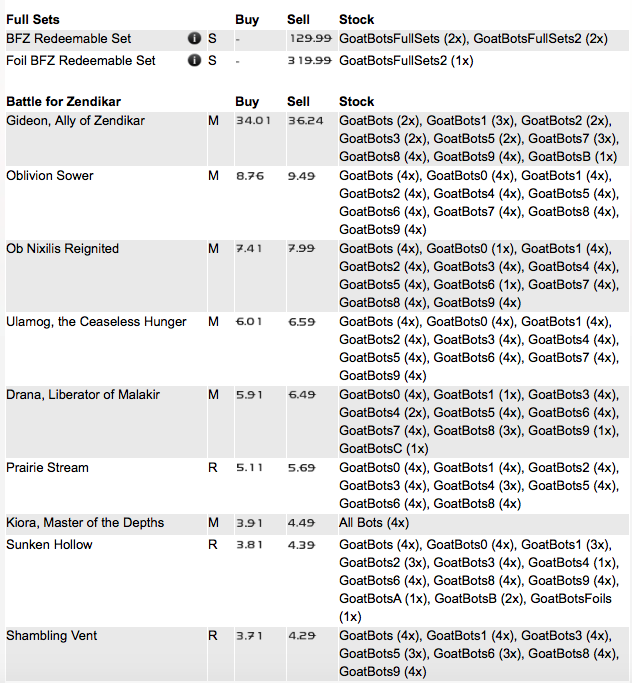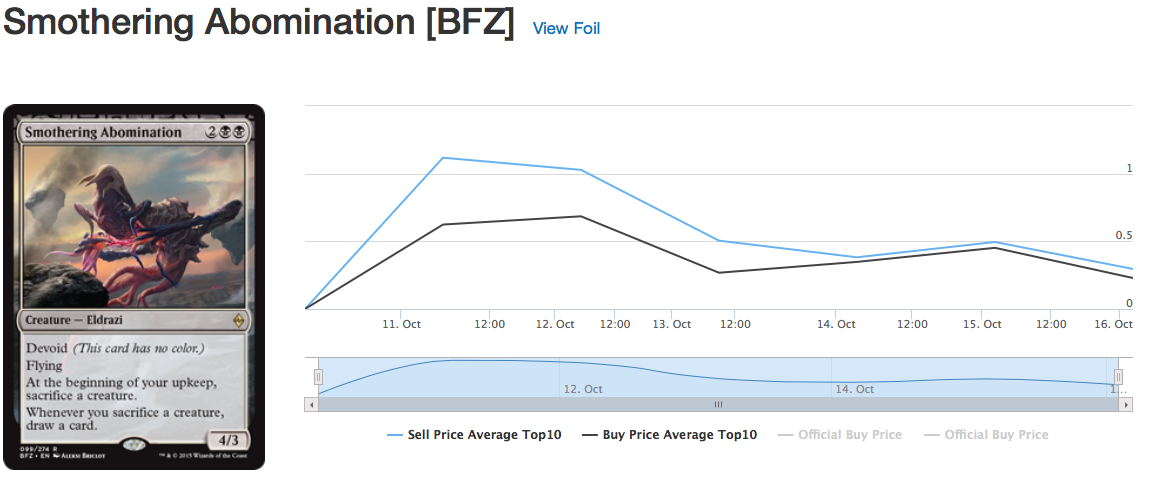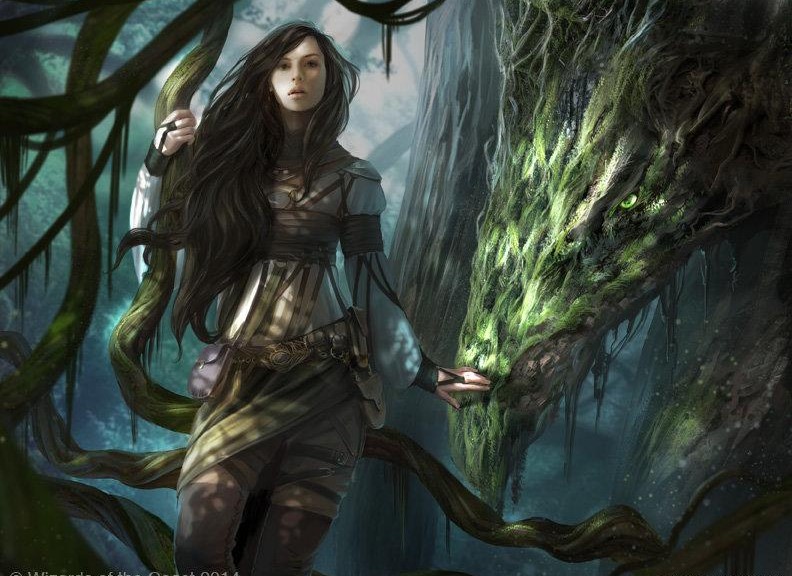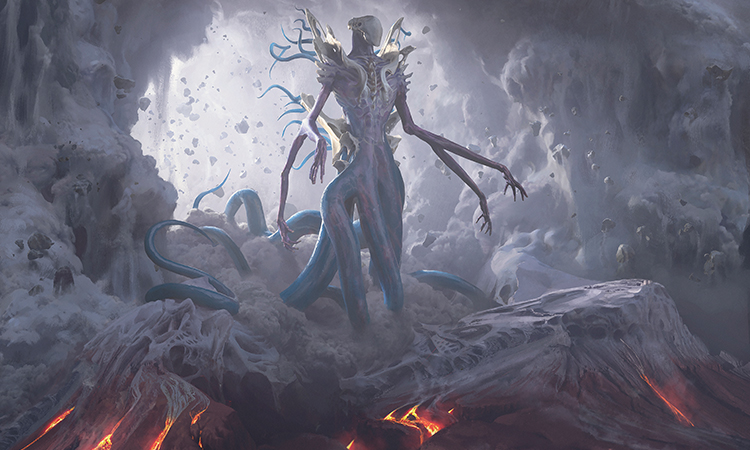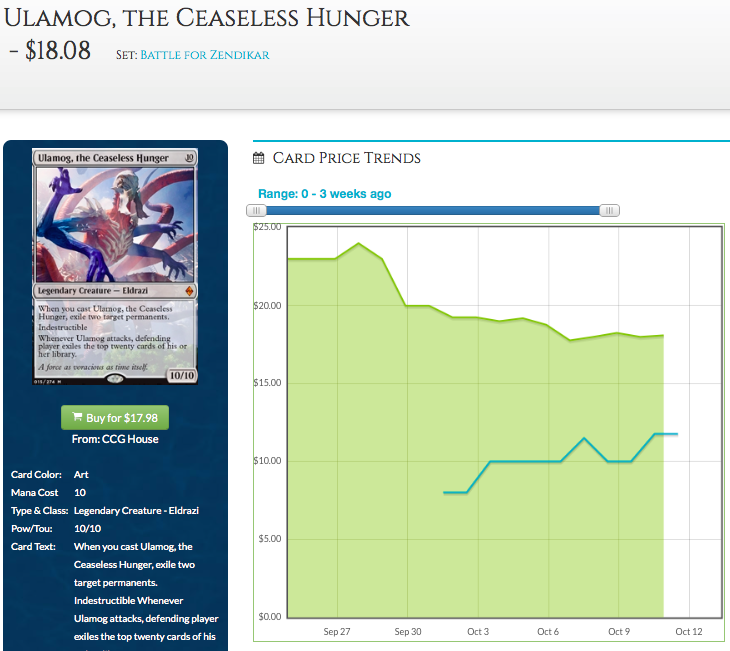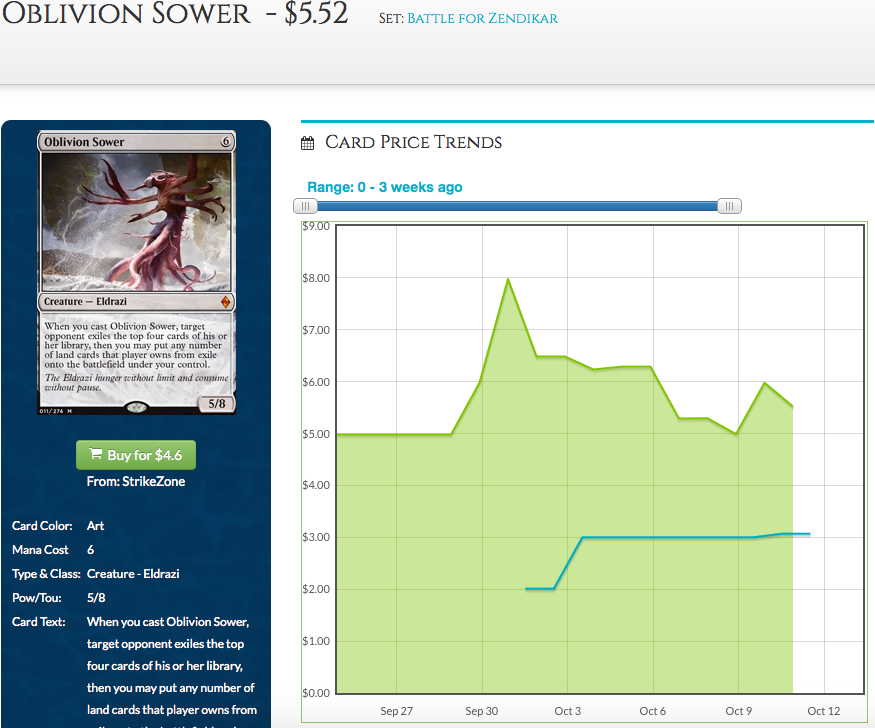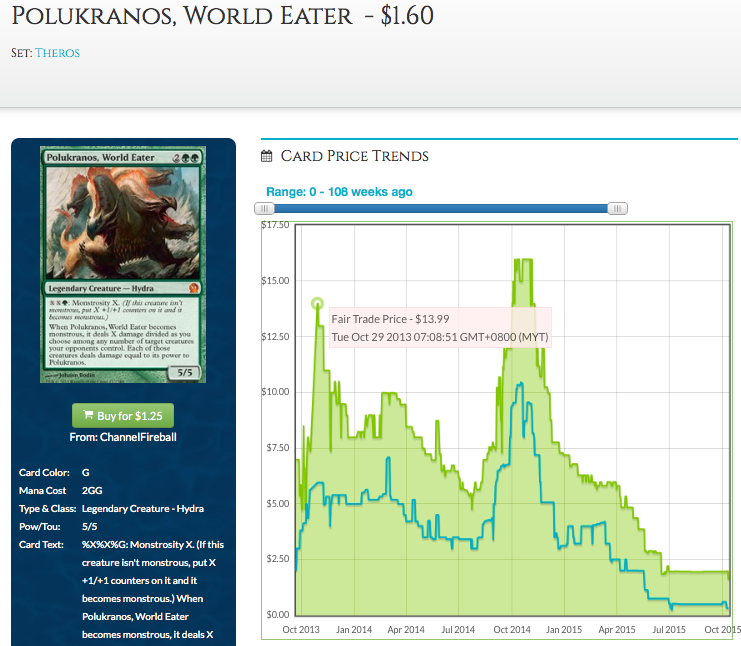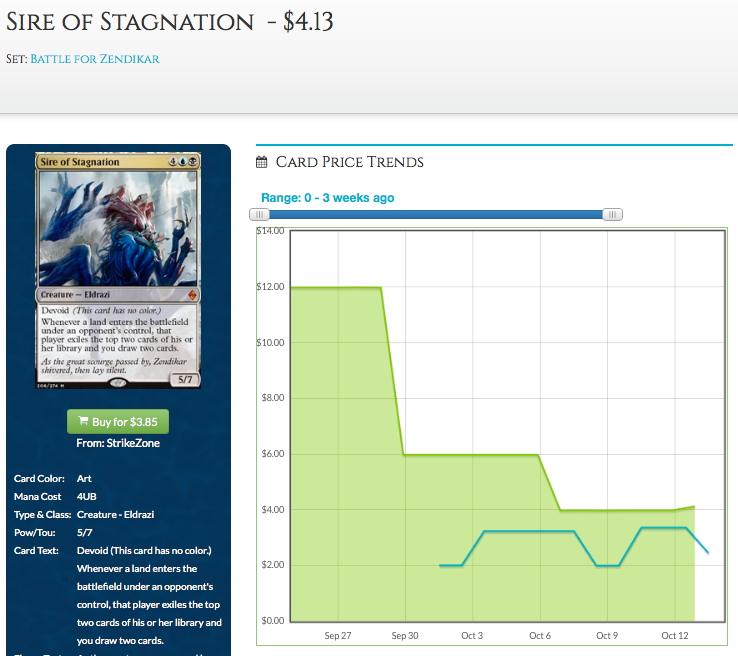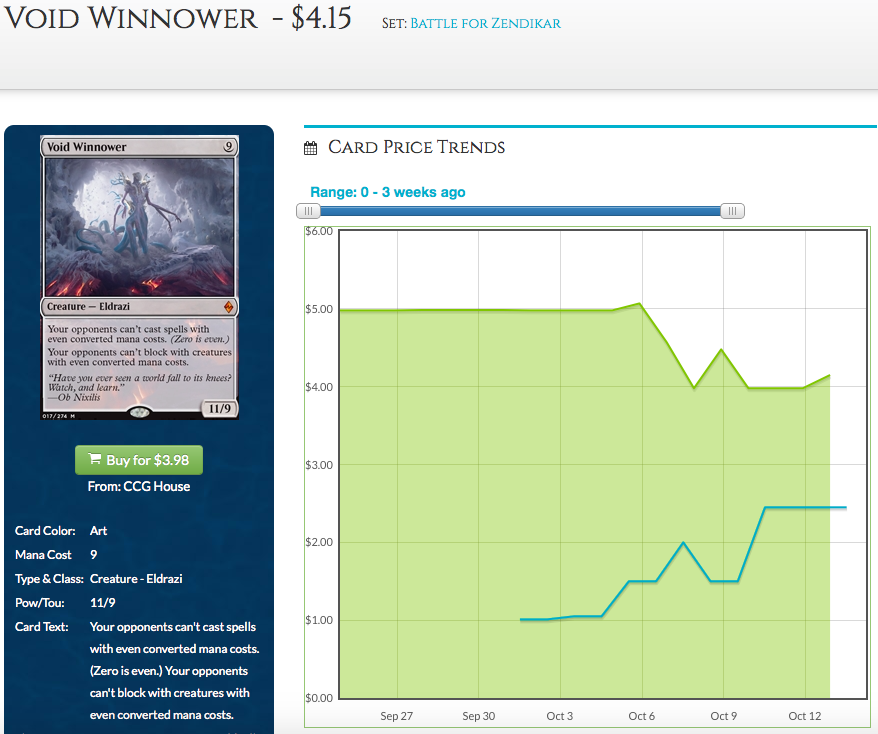The stage is set for a weekend of epic card battles. Despite a fairly muted response to the constructed playable cards of Battle for Zendikar, we find ourselves facing down a neatly refreshed metagame with multiple viable archetypes. After weeks of secretive testing, the top Magic teams on the planet have gathered for another epic battle between top Magic: The Gathering pros from across the globe. Over $250,000 USD is on the line, with the winner taking home a hefty $40,000 after three days of intense competition in in Milwaukee Wisconsin, USA.
As per usual, the Pro Tour weekends now feature a mix of booster draft (BFZ-BFZ-BFZ) and constructed formats with 3 rounds of draft Friday morning, followed by 5 rounds of Standard starting around 4-5pm EST.
For the MTG Finance community, the big question on all of our minds is whether any new cards from Battle for Zendikar will buck the trends of the first two major SCG Open tournaments of the season, and burst into the spotlight in Standard to push our recent specs into profitability. Will an overlooked card from the last block suddenly become key tech? Will there be a chance to get in on a must-have card that shows early promise or will the hype train leave the bandwagon speculators out in the cold without buyers come Monday morning?
With the Expedition lands suppressing the price of the rest of the cards in Battle for Zendikar, the conditions are right for some big spikes this weekend, though no-shows will find their prices undercut even further.
Many of the top teams have been in stealth mode for the last couple of weeks, furtively holed up in chilly northern hotels and AirBnB pads, attempting to break a format open that has stubbornly clustered around Jeskai Black, G/W Megamorpth & Ataraka Red thus far.
Pre-Game Top 8 Contenders
The early weeks of the new Standard format have demonstrated a fairly limited number of Tier 1 strategies that have a chance at dominance this weekend:
- Jeskai Black
- G/W Megamorph
- Atarka Red
The most popular Tier 2 strategies to date have included:
- Abzan Aggro
- Abzan Control
- Golgari/Jund Aristocrats
- G/W Hardened Scales
With all of the testing this week there’s also the distinct possibility that this weekend will mark the debut of a sweet new brew, with my bet being on either an Eldrazi Ramp strategy or a B/W Mid-Range build leveraging Wasteland Strangler to emerge from the pack . With Standard starting before most of us are home from work, the stage is set for first mover advantage if an unexpected deck jumps out to an early lead in the hands of a reliable pilot. Which deck are you rooting for?
Cards to Watch
Gideon, Ally of Zendikar: Don’t Underestimate The General
28 of the top 32 decks at the SCG Open in Atlanta last weekend featured white cards, a color that has long been thought to be underpowered in Standard. With 4-of appearances in the winning G/W Megamorph deck and the 4th place Jeskai Black deck, as well as 3-of usage in the 5th place Bant Megamorph deck and the 7th place Jeskai Dragons. Facing peak supply, Gideon is still holding the top price tag in his set, and at $32 could easily pop above $40 if he wins big this weekend.
Ulamog, the Ceaseless Hunger: Is Ramp Real?
No one is denying that Ulamog is one of the most powerful things to be doing in a deck that wants to ramp. The problem thus far has been that most decks have cheaper options to put away the game in Dragonmaster Atarka, Silumgar the Drifting Death or Ugin, the Spirit Dragon. With a fast, grindy format expected, the appearance of a strong ramp strategy may be an outside shot, but at $13, there is certainly upside if our tentacled overlord makes a strong showing.
Jace, Vrin’s Prodigy: Set to Dominate?
Once an underestimated $10 pre-order, Jace, Vryn’s Prodigy has now blown through the ceiling for a Standard legal mythic, spiking towards $80 before falling back to $65 recently. Mostly being used in the various Jeskai builds at the top tables, Jace’s price direction coming out of the weekend should depend on whether he makes the Top 8. A miss could easily see the card fall back to $50-55, which a strong showing like SCG Atlanta could easily drive a fresh spike in the $5-10 range. As a strong believer in the future of Jace in older formats, I am actively looking for an entry point under $50.
Oblivion Sower: The Ramp Enabler?
No one denies that the creature is powerful, and fooling around with exile effects certainly brings some popular side benefits, but we’re still waiting for a viable ramp strategy to show that it can hold back the early aggro decks for a long enough to set up camp. So far, nothing exciting has emerged, so this could be a card set to sink yet further coming out of the weekend.
Wasteland Strangler: 2nd Coming of Flametongue Kavu?
With Hangarback Walker being played everywhere coming out of late summer, the format has shifted to a preference for exile effects, with cards like Silkwrap, Complete Disregard and Utter End seeing increased play. Consequently, the stage is set for this dangerous creature to find a home in a B/W Tempo Deck similar to the one I’ve been testing lately with exile effects, Drana, Gideon, Seeker of the Way, Sorin and Wingmate Roc. Being able to kill an early threat, and then take out a Deathmist Raptor or Mantis Rider should not be underestimated, and at just $.40, I’d love to see a big pro give me a reason to go deep on this portable 2-for-1.
Dragonlord Ojutai: Time to Flee?
Despite my misgivings in late summer, Ojutai has managed to find a second spike in the $30 range, and is now sliding back toward $25 on lessened play facing a metagame full of sacrifice effects, led by Crackling Doom out of the Jeskai Black decks. If that trend continues I would expect to see limited play from the Azorious Dragonlord this weekend, and a further slide back toward $20.
Here are some other interestingly cheap cards, that could spike hard on unexpected strong play this weekend:
- Demonic Pact ($2.50): The Demonic Pact decks have been hovering in the shadows, waiting to pounce once someone figures out the right build to leverage the extreme card advantage inherent to the archetype. As a mythic from Magic Origins, the card could pop hard if anyone ever figures it out.
- Lilianna, Heretical Healer ($15): The nasty necromancer hasn’t found a strong home yet, but could be a key component in a rebuild of the GB Aristocrats decks that have been squeezing a few copies into the Top 32 of early tournaments. Smothering Abomination, sitting under $.50, could also pop if this deck does well.
- Jeskai Ascendancy: This formerly dominant Standard player has been sidelined for months at $0.75, but could be primed to bounce back on a good showing from Jeskai Tokens decks.
Stay tuned for Round by Round MTGFinance coverage of Pro Tour Magic Origins all weekend!
Round 4 (1st Round of Constructed)
- Gabriel Nassif (GB Aristocrats) vs Frank Karsten (Atarka Red)
- Martin Dang (Jeskai Tokens) vs Joel Larsson (Jeskai Tokens)
Both of these recent Pro Tour winners are on a Jeskai Ascendancy build with Gideon, leveraging a pile of tokens via Goblin Fodder and Hordeling Outburst to try and go wide on opponents.Jace is also present in both decks. The players split the first two games.
- Antonio Del Moral Leon (Esper Dragons) vs Yuta Takahashi (Abzan Control)
Deck Tech #1: Adrian Sullivan on Esper Demonic Pact Control
This card leverages Demonic Pact via Disperse, Silumgar’s Command and Utter End. Also runs a bunch of Esper Dragons style control cards.
Round 5: (2nd Round of Constructed)
- Gerry Thompson (Mardu Dragons) vs. Paul Cheon (Naya Megamorph)
Thompson is running Sarkhan, Dragonspeaker alongside a full grip of Thunderbreak Regents. Cheon’s deck makes user of Hangarback Walker, Nissa, Gideon, Dromoka’s Command and Wingmate Roc. Cheon takes the first game on the back of multiple Rocs.
- Jon Stern (Atarka Red) vs. Marcos Paylo De Jesus Freitas (Naya Eldrazi)
In Game 1, Marcos fails to ramp in time to stem the aggressive tide from Jon Stern.
- Owen Turtenwald (Dark Jeskai) vs. Makihito Mihara (Blue Abzan)
Owen is on a fairly familiar Jeskai Black build, while Mihara is playing Treasure Cruise alongside the usual Abzan cards. Owen takes Game 1 down with the help of Jace recursion on Roast. Mihara bounces back to take game 2. Mihara steals a noteable Dragonmaster Outcast with Exert Influence in Game 3. Mihara also running a miser Bring to Light, and manages to take the match.
Deck Tech #2: Dan Ward on Temur/Jeskai Dragons
This deck features:
- 4 Beastcaller Savant
- 4 Rattleclaw Mystic
- 4 Mantis Rider
- 3 Savage Knuckblade
- 4 Woodland Wanderer
- 4 Thunderbreak Regent
- 4 Icefall Regent
- 4 Draconic Roar
- 2 Jeskai Charm
- 2 Stubborn Denial
Round 6: (3rd Round of Constructed)
- Oliver Polak-Rottman (Esper Control 5-0) vs. Jacob Wilson (Dark Jeskai 5-0)
Wilson takes the match 2-0 to advance to 6-0 as Oliver resigns from the match in frustration after a misplay.
- Christian Calcano (UB Aristocrats) vs. Peter Vieren (Esper Control)
Calcano takes down his match with his innovative color shifted version of Aristocrats.
- Makihito Mihara (Blue Abzan) vs. Owen Turtenwald (Dark Jeskai)
Mihara’s innovative Abzan build splashes blue for Jace, Everywhere Prodigy and Treasure Cruise. Turtenwald is on a fairly standard Dark Jeskai build, leveraging Crackling Doom and Tasigur for value. The match was a grindy and technical affair, but Mihara managed to come out on top after three.
Deck Tech #3: G/W Megamorph
Michael Majors is showing off his updated build of the expected G/W Megamorph deck.
Round 7: (4th Round of Constructed)
- Paulo Vitor Damo da Rosa (7-0, Atarka Red) vs. Yuta Takahashi (7-0 Abzan Aggro)
Both builds were fairly well known here. PVD takes it down 2-1.
Round 8: (5th Round of Constructed)
- Magnus Lantto (Esper Planeswalkers) vs. Ryoichi Tamada (Jeskai)
Lantto’s deck represents a revised version of earlier Esper Dragons control builds, with Ob Nixilis, Reignited and Gideon, Ally of Zendikar standing in for the cards no one wants to lose to Crackling Doom or Foul Tongue Invocation this weekend. Tamada chose to eschew a 4th color alongside his streamlined Jeskai build, looking to ensure that Jeskai Charm could consistently push through the final points of damage. The strategy paid off again here, with Tamada taking the match in two games, and leaving him at 7-1 on the day.
At the end of Day 1, only Eric Severson remains undefeated, with his Jeskai Black build.
Our Day 1 Metagame breakdown looks as follows (% of field in brackets):
- Atarka Red: 14.4%
- Dark Jeskai: 13.90%
- Green-White Megamorph: 10.90%
- Esper Dragons: 6.30%
- Abzan: 4.90%
- Esper Control: 4.10%
- Red-Green Landfall: 3.80%
- Blue Abzan: 3.00%
- Naya Megamorph: 3.00%
Though the three decks with the best records in recent weeks occupy our top slots and make up a full 40% of the metagame, the field is still relatively wide open with more than 20 distinct deck types representing at least 1% of the field. This likely indicates that team testing resulted in no certain feel for the best deck in the format, and a relative lack of reliable trumps against a field full of diverse threats and answers. In such a format we can likely expect to see both skill and experience contribute strongly to our winner.
Full details on the metagame can be found here.
Join us at 11am Saturday for Day 2 coverage of Pro Tour: Battle for Zendikar!
James Chillcott is the CEO of ShelfLife.net, The Future of Collecting, Senior Partner at Advoca, a designer, adventurer, toy fanatic and an avid Magic player and collector since 1994.
